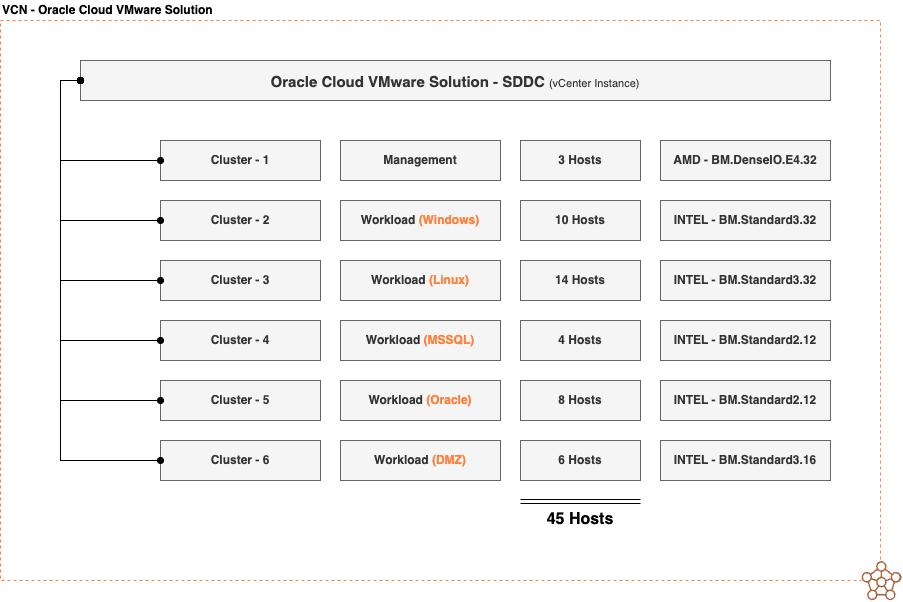With Oracle Cloud VMware Solution, Oracle has a unique offering in the market when it comes to cloud VMware solutions, providing the following features and benefits:
- Support for VMware vSphere 7 and VMware vSphere 8
- VMware licensing and support included
- Deployed within the customers own virtual cloud network (VCN)
- Full root access for the customer. Oracle has no access to the software-define data center (SDDC)
- Native Layer 2 networking
- Full perimeter security control
- Global single rate card and predictable pricing
- Widest number of bare metal shapes in the market
- Multicluster support in a SDDC
Today, we’re focusing on the multicluster SDDC. A blog post from December 2023 introduced the support for Oracle Cloud VMware Solution with multiple clusters. The post focuses on the default deployment and introduction of the feature itself.
In this post, we focus on the options beyond the soft limit of six clusters per SDDC and look deeper into the provisioning scenarios and how to customize a deployment beyond the soft limits of Oracle Cloud VMware Solution.
Multihost SDDC with multiple clusters
Multihost SDDCs provide high availability, and you can use the full range of VMware Solution features to migrate and support production workloads. You can create a multihost SDDC with up to six clusters, containing up to 64 hosts each, resulting in a maximum of 384 hosts per SDDC. Each cluster can contain many ESXi hosts to support the specific workload requirements of the cluster. SDDCs require a unified management cluster to host the VMware management components, which is created as part of the SDDC setup workflow.

Any clusters that you create after the unified management cluster are workload clusters and don’t contain any management components. The number of ESXi hosts that you can create in a workload cluster depends on the compute shape you select for the cluster.
With this deployment, you also have the choice of the bare metal shape to choose for your cluster. This freedom allows for a mixed mode of shapes within an SDDC, but mixing Intel-based shapes and AMD-based shapes in a cluster isn’t supported, nor is mixing DenseIO and standard shapes.
Going beyond the soft limits
The current limit of six clusters in the diagram is currently related to the deployment guide, but you can change it in Day two operations. Because vSphere clusters are just a logical construct within the vCenter server, you can split these initial six clusters into smaller chunks, but the minimum count of three hosts per cluster must be kept to align with the Oracle Support policies.

By splitting the clusters into smaller chunks and adding more hosts, you can go far beyond the soft limit of six clusters per SDDC. Keep in mind that this operation is a Day 2 job that only VMware experts should do. These tasks require good planning and a well-defined execution and test plan.

Day 2 operations
The process is simple. Start with the deployment of Oracle Cloud VMware solution through the Oracle Cloud Console and create a basic setup with one management cluster and five workload clusters. Choose the right shapes because you’re limited to these shapes.
After that, you can break up a cluster. The initial host count must be at least six hosts. Otherwise, you can’t split them into two three-node clusters for separation. Put the ESXi host into maintenance mode and ensure that the clusters have separated storage resources.

Conclusion
Oracle Cloud VMware Solution’s multicluster SDDC feature empowers you to take your VMware environment in the cloud to new heights. With simplified management, workload separation, cost efficiency, cluster variety, and scalability, this feature offers a comprehensive solution tailored to your organization’s specific needs.
Whether you want to optimize your licensing costs, segregate workloads, or harness specialized clusters, multicluster SDDC is the answer. This new product enhancement allows you to optimize your VMware environment in the cloud with Oracle Cloud VMware Solution.
Take the first step today. Follow this guide to create your own multi-cluster SDDC or add a workload cluster to an SDDC and witness the power of cloud-enabled VMware, redefined.
If you’re interested, contact our Oracle Cloud VMware Solution Specialists. We can provide you the level of support required to make your project a success. For more information, see the following resources:
